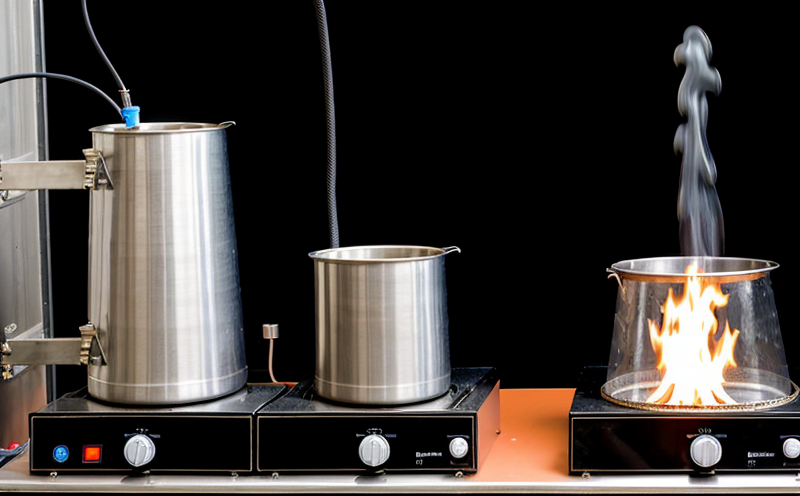Heat Release and Flame Spread Correlation
The process of heat release during combustion is a critical parameter in fire safety testing. Heat release rate (HRR) quantifies the amount of energy released by burning materials, which plays a crucial role in understanding the behavior of materials under fire conditions. The relationship between heat release and flame spread is essential for predicting the potential for a material to sustain or propagate a fire. This service, Heat Release and Flame Spread Correlation, provides a comprehensive analysis that links these two key factors.
The primary objective of this testing is to assess how quickly and intensely materials can release heat during combustion. The rate at which the material burns directly influences its potential for causing rapid fire spread in real-world scenarios. By evaluating both HRR and flame spread, we can better understand not only how a material behaves when exposed to flames but also how it contributes to or mitigates fire hazards.
Our testing approach involves several stages, each designed to provide detailed insights into the material's performance under controlled conditions that mimic real-world fire scenarios. Specimens are carefully prepared and subjected to standardized tests where they are exposed to a flame source. The heat release is measured using a Cone Calorimeter or other similar apparatuses, which can accurately capture the HRR over time.
The flame spread characteristics are also meticulously documented, providing critical data on how quickly the fire spreads across the surface of the specimen. This information is invaluable for determining not only the material's flammability but also its resistance to spreading flames to adjacent materials.
Understanding these parameters helps in designing safer products and environments by identifying materials that can significantly reduce fire risk. The insights gained from this testing are crucial for various industries, including building materials, textiles, furniture manufacturing, and automotive sectors. It is particularly important for compliance with international standards such as ISO 56601-2:2019 or ASTM E907.
For quality managers and R&D engineers, this testing ensures that products meet stringent safety requirements while also being innovative and sustainable. By correlating heat release rates with flame spread, we can optimize product designs to enhance fire safety without compromising functionality.
Customer Impact and Satisfaction
- Enhanced Product Safety: Our clients benefit from improved product safety by ensuring their materials meet the highest fire safety standards. This reduces the risk of fires in end-use environments.
- We work closely with our clients to ensure that all testing aligns with specific industry requirements and regulatory expectations.
- Increased Market Share: By demonstrating a commitment to fire safety, companies can gain a competitive edge in the market. This service helps them differentiate their products from those of competitors who may not prioritize such testing.
Our clients also appreciate the detailed and actionable reports we provide, which help them make informed decisions about material selection and design improvements. The insights gained through this testing are invaluable for R&D teams looking to innovate and improve product safety features.
Environmental and Sustainability Contributions
The environmental impact of materials is a growing concern in today's sustainability-driven world. By providing accurate data on heat release rates and flame spread, we contribute to more sustainable design practices. This testing helps identify materials that can reduce fire risks without compromising functionality or performance.
- Reduced Fire Hazards: Lowering the heat release rate of materials decreases the likelihood of fires spreading rapidly in buildings or other structures. This results in safer environments for occupants and less risk to property damage.
- Our testing ensures that materials are not only safe but also contribute positively to sustainable building practices.
- Eco-friendly Product Design: By incorporating the insights from our testing into product design, companies can create eco-friendly products that perform well in fire safety scenarios. This aligns with broader sustainability goals and contributes to a greener future.
Incorporating these principles into manufacturing processes not only enhances product safety but also supports environmental initiatives aimed at reducing the carbon footprint of industrial operations.
Competitive Advantage and Market Impact
- Regulatory Compliance: By staying ahead in fire safety testing, companies can ensure compliance with international standards such as ISO 56601-2:2019 or ASTM E907. This not only protects against potential legal risks but also enhances the reputation of your brand.
- Our expertise ensures that you are always meeting the latest regulatory requirements, giving you a competitive edge in the market.
This service is not just about compliance; it's about staying ahead of the curve in fire safety innovation. By leveraging the data we provide, companies can gain a competitive advantage that sets them apart from their rivals.





